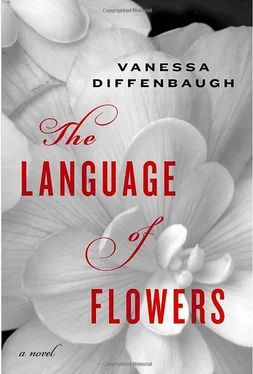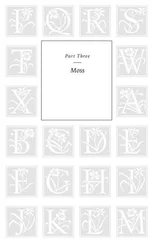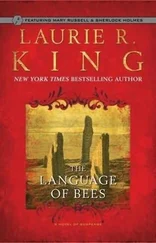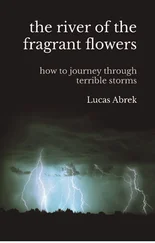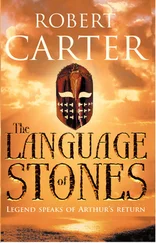On Christmas Eve, every photo had been mounted and dried. Natalya and her band had gone wherever people go for the holidays, and the apartment was deliciously quiet. Carrying the photo boxes downstairs, I spread the cards out in the empty practice room in neat rows, with aisles wide enough for me to walk down. The cards for the orange box I placed flower side up, the cards for the blue box flower side down. I paced the aisles for hours, alphabetizing first the flowers, then the meanings. When I was done, I replaced all the cards in the boxes and opened Elizabeth’s flower dictionary to admire my progress. It was the middle of winter, and my illustrated dictionary was already half finished.
The pizzeria at the top of the hill was deserted. I took my pizza to go and ate it on Natalya’s bed, looking down over the empty street below. Afterward, I lay down in the blue room. Even though it was quiet, warm, and dark, my eyes kept popping open. A sliver of pale white light shone from the streetlight into Natalya’s room and pushed its way through the crack in the closet door. The light was pencil-thin and drew a line down the wall opposite and through the middle of my photo boxes. The blue box was exactly the same color as the wall, and the orange box, sitting on top of it, looked like it was floating in air. It didn’t belong there.
It belonged on Grant’s bookshelf, across from his orange couch. I had chosen the color specifically for that purpose, even though I hadn’t admitted it to myself. Grant was gone. The need to avoid flower-language miscommunications no longer existed, yet I had purchased an extra box, an orange box, and made a second set of cards. I unlocked the half-door leading to the living room and put the orange box out.
Grant did not comeover for blackberry cobbler. He should have , I thought, licking the bottom of the dish the next morning. It was delicious.
As I set the dish in the sink, Elizabeth swept through the back door, breathless. Her hair was loose around her shoulders, and I realized that I had never, in nearly a year, seen her without a tight bun at the back of her neck. She smiled, her eyes filled with an unrestrained happiness I’d never seen.
“I’ve figured it out!” she said. “It’s absurd I didn’t think of it sooner.”
“What?” I asked. Her joy made me inexplicably nervous. Licking congealed blackberry juice off a spoon, I watched her.
“When I was at boarding school, Catherine and I wrote letters—until my mother started intercepting them.”
“Intercepting?”
“Taking. She read them all—she didn’t trust me, thought somehow my letters would corrupt Catherine, even though I was a child and Catherine was already nearly an adult. For years we didn’t write at all. But just after my sister’s twentieth birthday, she discovered a Victorian flower dictionary on my grandfather’s bookshelf. She started sending me drawings of flowers, the scientific name printed neatly in the bottom right-hand corner. She sent dozens before following with a simple note that read, ‘Do you know what I’m telling you?’ ”
“Did you know?” I asked.
“No,” Elizabeth said, shaking her head as if remembering her adolescent frustration. “I asked every librarian and teacher I could find. But it was months before my roommate’s great-grandmother, visiting one day, saw the drawings on my wall and told me about the language of flowers. I found my own dictionary in the library and sent my sister a note immediately, with pressed flowers, not drawings, because I was a hopeless artist.”
Elizabeth walked into the living room and returned with a stack of books. She set them on the kitchen table. “For years it was the way we communicated. I sent poems and stories by connecting dried flowers on strings, intertwined with typed words on little slips of paper: and, the, if, it . My sister continued to send drawings, sometimes whole landscapes, with dozens of floral varieties, all labeled and numbered, so I would know which flower to read first to decode the sequence of events and emotions in her life. I lived for those letters, checked the mailbox dozens of times a day.”
“So, how will this help you win her forgiveness?” I asked.
Elizabeth had started toward the garden but stopped suddenly and whirled to face me. “ I’m forgiving her ,” she said. “Don’t you forget that.” After a deep breath, she continued. “But I’ll tell you how it will help. Catherine will remember how close we were; she’ll remember how I understood her better than anyone else in the world. And even if she’s too remorseful to answer the phone, she’ll answer with flowers. I know she will.”
Elizabeth went outside. When she returned, she held a bouquet of three flowers, all different. Retrieving a cutting board from the counter, she set it on the kitchen table, the flowers and a sharp knife arranged on top.
“I’ll teach you,” Elizabeth said. “And you’ll help me.”
I sat down at the kitchen table. Elizabeth had continued to teach me flowers and their meanings but not in a formal or structured way. The day before we’d passed a handmade purse at the farmer’s market, the fabric printed with small white flowers. Poverty for a purse , Elizabeth had said, shaking her head. She pointed to the flowers and explained the defining features of clematis.
Sitting next to her now, I was thrilled at the prospect of receiving a formal lesson. I pushed my chair as close to Elizabeth as possible. She picked up a walnut-sized dark purple flower with a yellow sun center.
“Primrose,” she said, twirling the pinwheel-shaped flower between her thumb and index finger before placing it, face up, on her smooth white palm. “Childhood.”
I leaned over her hand, my nose only inches from the petals. The primrose had a sharp scent, sugared alcohol and someone’s mother’s perfume. Pulling my nose away, I pushed the air out of my nostrils with force.
Elizabeth laughed. “I don’t like the smell, either. Too sweet, as if it was trying to mask its true, undesirable smell.”
I nodded in agreement.
“So, if we didn’t know this was a primrose, how would we find out?” Elizabeth put down the flower and picked up a pocket-sized book. “This is a field guide of North American wildflowers, divided by color. Primrose should be with the violet-blues.” She handed me the book. I turned to the violet-blues, flipping through the pages until I found the drawing that matched the flower.
“Cusick’s primrose,” I read. “Primrose family, Primulaceae.”
“Good.” She picked up the second of the three flowers, large and yellow, with six pointed petals. “Now this. Lily, majesty. ”
Searching the yellows, I found the drawing that matched. I pointed with a damp fingertip and watched the water mark spread. Elizabeth nodded.
“Now, let’s pretend you couldn’t find the drawing, or you weren’t sure you had found the right one. This is when you need to know about flower parts. Using a field guide is like reading a Choose Your Own Adventure book. It begins with simple questions: Does your flower have petals? How many? And each answer leads you to a different set of more complicated questions.”
Elizabeth picked up a kitchen knife and sliced the lily in half, its petals falling open on the cutting board. She pointed to the ovary, pressed my fingertip against the sticky top of the outstretched stigma.
We counted petals, described their shape. Elizabeth taught me the definition of symmetry, the difference between inferior and superior ovaries, and the variations of flower arrangements on a stem. She quizzed me using the third flower she had picked, a violet, small and wilting.
Читать дальше
